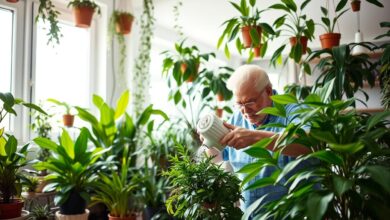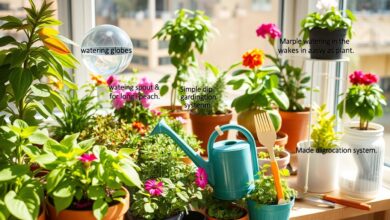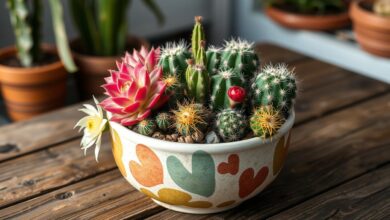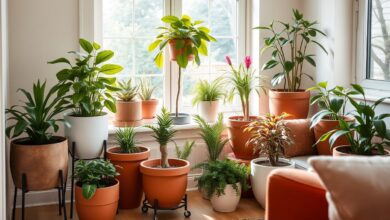Indoor Vegetable Gardening for Seniors: Easy Tips
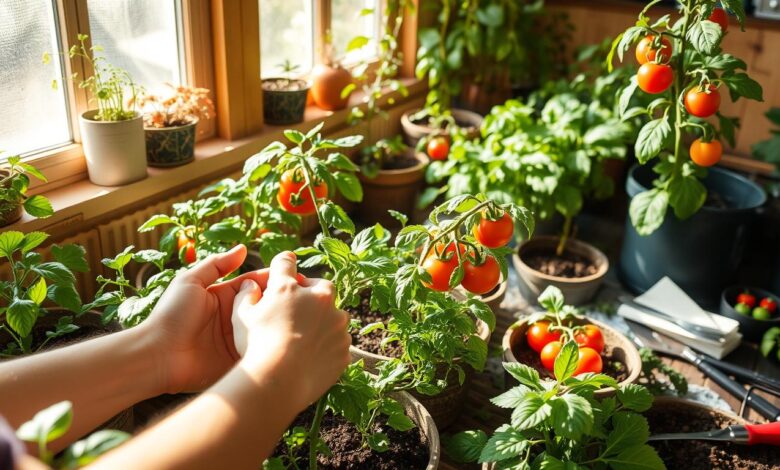
Outdoor gardening isn’t a necessity for older adults who enjoy cultivating plants. Indoor vegetable gardening for seniors offers a solution for elderly gardeners living in apartments, senior living facilities, or those who may not be as mobile as they once were. This type of easy indoor gardening can help combat depression, stress, and loneliness, and may even reduce the risk of dementia. In this article, we’ll provide simple tips for successful senior-friendly gardening and low-maintenance vegetables that thrive indoors.
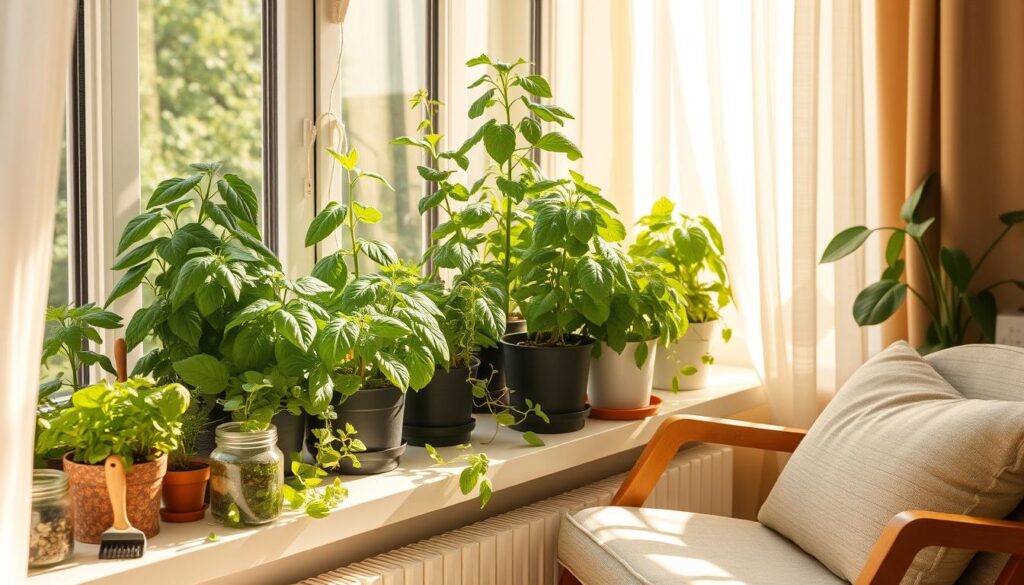
Table of Contents
Key Takeaways
- Indoor gardening can benefit seniors by reducing the risk of dementia and related illnesses.
- Succulents, snake plants, and African violets are easy-to-care-for indoor plants suitable for older adults.
- Container gardening for beginners allows seniors to grow vegetables and herbs in small spaces.
- Vertical gardens and terrariums are convenient indoor gardening options for seniors.
- Proper container selection and potting mix are essential for successful small space gardening.
Introduction to Indoor Gardening for Seniors
As we age, our physical and mental capabilities may face certain limitations, but that doesn’t mean we have to give up our lifelong passion for gardening. Indoor gardening offers a fantastic solution for seniors who want to continue cultivating their green thumbs, even in the comfort of their own homes.
Benefits of Indoor Gardening for Older Adults
The advantages of indoor gardening for seniors are numerous. It helps to increase physical activity, lower depression, relieve stress and anxiety, and provide a sense of accomplishment. Research shows that having live plants in the house benefits well-being. Engaging in this hobby can also boost mental stimulation and cognitive function, making it an ideal activity for older adults.
Types of Indoor Gardens Suitable for Seniors
When it comes to indoor garden types for seniors, there are several options that cater to their needs and preferences. Some of the best choices include:
- Vertical gardens: These space-saving solutions allow seniors to grow a variety of edible plants and flowers without taking up too much floor space.
- Terrariums: These self-sustaining mini-ecosystems require minimal maintenance, making them an excellent choice for seniors.
- Windowsill herb gardens: Aromatic herbs like mint, basil, and rosemary can thrive in sunny windowsills, providing a convenient source of fresh flavors.
- Succulent gardens: Low-maintenance succulents and cacti add a touch of natural beauty to any indoor space.
By exploring these indoor gardening options for seniors, older adults can continue to reap the physical, mental, and emotional benefits of cultivating their own plants, even in the comfort of their own homes.
Vertical Gardens: A Convenient Option
Vertical gardens are an excellent choice for seniors who may have limited mobility or space for traditional gardening. These space-saving structures allow plants to grow upwards, rather than outwards, making them easier to maintain and access. Whether indoors or outdoors, vertical gardens offer a convenient solution for seniors to enjoy the benefits of gardening with less physical strain.
Best Vegetables for Vertical Gardens
When it comes to the best vegetables for vertical gardens, there are several options that thrive in this type of setup. Some of the top choices include:
- Tomatoes
- Cucumbers
- Squash
- Cauliflower
- Strawberries
- Leafy greens
These compact, climbing, or trailing vegetables are well-suited for vertical gardens, allowing seniors to enjoy a bountiful harvest without the need for extensive bending or kneeling.
Best Flowers and Plants for Vertical Gardens
In addition to vegetables, vertical gardens can also showcase a variety of beautiful flowers and plants. Some of the best options for seniors include:
- American honeysuckle
- Caladium
- Achiote
- Peace lily
- Pansies
These low-maintenance, vibrant plants can add a touch of color and life to any vertical garden, creating a visually stunning and rewarding gardening experience for seniors.
Vertical gardens offer a convenient and accessible way for seniors to enjoy the benefits of indoor and outdoor gardening. By selecting the right vegetables, flowers, and plants, seniors can create thriving, low-maintenance gardens that cater to their unique needs and preferences.
Terrariums: Mini Greenhouses for Indoor Gardening
For seniors who may find vertical gardens too much work, terrariums offer an excellent alternative to bring the joy of indoor gardening. Terrariums are essentially mini-greenhouses – enclosed glass containers that house a variety of low-maintenance plants. These self-sustaining ecosystems require little effort, as the plants and soil release water vapor that collects on the walls and trickles back down, keeping the environment perfectly hydrated.
Terrariums have a rich history, first discovered by Dr. Nathaniel Ward in 1827 as a way to study sensitive tropical plants. Since then, these miniature gardens have become a popular way for both botanists and everyday gardeners to cultivate a diverse range of houseplants. From bottle gardens and fish tanks to large mixing bowls, the possibilities for terrarium structures are endless.
When it comes to plant selection, terrariums thrive with a variety of species, including Sweet Flag, Ferns, Spiderwort, African Violets, and Coffee Plant. Most prefer bright, indirect light, with the exception of orchids and bromeliads, which can handle direct sunlight. Caring for a terrarium is a breeze – gentle watering, no fertilization, and occasional refreshing of the potting medium is all that’s needed to keep these mini-greenhouses looking their best.
“Interaction with indoor plants may reduce psychological and physiological stress levels in young adults, as surrounding oneself with plants can have a stress-reducing effect by suppressing autonomic nervous system activity.”
For seniors seeking a low-maintenance way to enjoy the benefits of indoor gardening, terrariums offer the perfect solution. These self-sustaining ecosystems provide a tranquil and visually appealing addition to any living space, allowing green-thumbed older adults to nurture their passion for plants with minimal effort.
| Terrarium Plant Recommendations | Light Requirements |
|---|---|
| Sweet Flag, Ferns, Spiderwort, African Violets, Coffee Plant | Bright, indirect light (except orchids and bromeliads, which can handle direct sunlight) |
Windowsill Herb Gardens: Grow Your Spice Rack
For older adults who are no longer as active but still enjoy cooking, a windowsill herb garden can be the perfect solution. Herb gardens thrive indoors, with compact containers that can be easily moved into the sun or kept out of reach of curious pets. The best herbs to grow on your windowsill include parsley, basil, rosemary, mint, thyme, oregano, stevia, lemongrass, and garlic chives.
Growing indoor herb gardens for seniors offers numerous benefits. Studies have shown that tending to plants can lower depression levels, provide physical activity, and help relieve stress and anxiety in older adults. Plus, the greenery can contribute to cleaner indoor air quality. Herbs are also low-maintenance, making them an ideal choice for those with limited mobility or dexterity.
When creating your windowsill herb garden, consider the specific sunlight and watering needs of each variety. Many culinary herbs thrive in 7-8 hours of direct sunlight per day and well-draining soil. Established perennial herbs like sage, rosemary, and thyme require less frequent feeding compared to annuals like basil and mint, which prefer consistently moist soil.
| Herb | Sunlight Needs | Watering Requirements | Health Benefits |
|---|---|---|---|
| Parsley | Full sun to partial shade | Keep soil moist | High in antioxidants, vitamins A and C |
| Basil | Full sun | Prefers consistently moist soil | Anti-inflammatory, supports heart health |
| Rosemary | Full sun | Drought-tolerant | Antioxidant-rich, may improve memory |
| Mint | Partial shade | Likes consistently moist soil | Aids digestion, may help relieve headaches |
With a little research and proper care, your windowsill herb garden can provide a bountiful harvest of fresh, flavorful herbs to enhance your cooking while also contributing to your overall wellbeing as an older adult.

Succulent Gardens: Low-Maintenance Beauty
For seniors looking to enjoy the benefits of indoor gardening without the hassle of high-maintenance plants, succulent gardens are an excellent choice. Succulents, such as jade, Christmas cactus, aloe vera, snake plant, and burro’s tail, are resilient and require minimal watering, making them the perfect low-maintenance indoor plants for seniors.
One of the key advantages of growing succulent gardens for seniors is their ability to thrive with little attention. Unlike many other houseplants, succulents can tolerate periods of neglect and still bounce back, reducing the stress and effort required for seniors to maintain a lush, vibrant indoor garden. These low-maintenance indoor plants for seniors are also resistant to pests and diseases, further simplifying the gardening experience.
Another appealing aspect of succulent gardens is their visual appeal. Succulents come in a wide array of shapes, sizes, and colors, allowing seniors to create visually striking and aesthetically pleasing arrangements. Whether planted in small pots or cascading from a larger container, these low-maintenance indoor plants for seniors can transform any indoor space into a stunning, natural oasis.
For seniors with limited mobility or space, succulent gardens offer a practical solution. Many succulents can be grown in compact containers or even vertically, making them an ideal choice for seniors with smaller living areas. The ease of care and eye-catching appearance of these low-maintenance indoor plants for seniors make them a fantastic addition to any indoor garden.
“Gardening is a great way for seniors to stay active, reduce stress, and enjoy the beauty of nature, even in small indoor spaces. Succulent gardens are a perfect choice for those looking for a low-maintenance, yet visually stunning, indoor gardening experience.”
By incorporating succulent gardens for seniors into their indoor spaces, older adults can reap the numerous benefits of gardening while minimizing the effort required. These low-maintenance indoor plants for seniors offer a simple and rewarding way to bring a touch of nature and tranquility to their living environments.
indoor vegetable gardening for seniors: Choose the Right Space
When it comes to indoor vegetable gardening for seniors, choosing the right space is crucial for your success. The primary factor to consider is light. While some windows may provide enough natural sunlight, you might need to use a grow light or a lamp with a full-spectrum bulb to ensure your plants receive the necessary illumination.
Avoid cold, drafty spaces as well as areas near heat vents and fireplaces. The ideal space should have good air circulation and be free of pests. Senior-friendly indoor gardening locations should be easily accessible, with minimal physical barriers or obstructions.
- Optimal Lighting: Seek out bright, well-lit areas in your home for your indoor vegetable garden.
- Temperature and Air Flow: Maintain a consistent, comfortable temperature and ensure adequate air circulation to promote healthy plant growth.
- Pest-Free Environment: Choose a location that is clean and protected from unwanted pests, ensuring the safety and longevity of your indoor garden.
By carefully selecting the right space for your indoor vegetable garden, you can create a thriving, low-maintenance oasis that provides fresh produce and a pleasant hobby for seniors to enjoy.
| Vegetable | Light Requirement | Soil Depth | Watering Needs |
|---|---|---|---|
| Lettuce | 6-8 hours of direct sunlight | 6-8 inches | Moist but not waterlogged |
| Tomatoes | 8-10 hours of direct sunlight | 12-16 inches | Consistently moist |
| Bell Peppers | 6-8 hours of direct sunlight | 12 inches | Moist but not saturated |
| Mushrooms | Low light (can grow in dark conditions) | 6-8 inches | Consistently moist |
By considering these key factors and selecting the right indoor gardening space, seniors can enjoy the benefits of choosing indoor gardening space for seniors and senior-friendly indoor gardening locations throughout the year.
Indoor Vegetable Garden Containers and Potting Mix
When it comes to indoor vegetable gardening, the right containers and potting mix are crucial for your seniors’ success. Selecting attractive and practical containers, as well as using high-quality potting mix, can make all the difference in growing a thriving indoor edible garden.
Selecting Attractive and Practical Containers
Seniors should look for containers with ample drainage holes to prevent root rot. While decorative pots can add a touch of style, functionality is the top priority. Self-watering planters are a convenient option that helps keep the soil moist and reduces the frequency of watering. Large containers are recommended for growing vegetables, as they provide more room for healthy root development.
Using High-Quality Potting Mix
Indoor vegetable gardening requires a lightweight, well-draining potting mix that won’t compact easily. Miracle-Gro® Performance Organics® All-Purpose Container Mix is an excellent choice, as it’s formulated with aged compost to provide the necessary nutrients for plants. Avoid using outdoor garden soil, as it may contain weed seeds, insects, and harmful bacteria that can compromise the health of your indoor garden.
With the right containers for indoor vegetable gardens and high-quality potting mix for indoor gardening, seniors can enjoy the rewards of a thriving indoor edible oasis all year round.
| Container Size | Recommended Vegetables |
|---|---|
| 12-inch diameter | Tomatoes, peppers, eggplants |
| 8-10 inch diameter | Leafy greens, herbs, radishes, carrots |
| 5-gallon pot | Potatoes, bush beans, zucchini |
Hydroponics: Growing Veggies in Water
For seniors interested in indoor vegetable gardening, hydroponics presents a convenient and low-maintenance option. Hydroponic systems allow plants to grow in water infused with essential nutrients, without the need for soil. This innovative approach can be particularly beneficial for older adults, as it requires less physical effort and space compared to traditional gardening.
One popular hydroponic system well-suited for seniors is the Miracle-Gro® Twelve™ Indoor Growing System. This all-in-one setup features a built-in LED light source, making it an ideal choice for those with limited mobility or space constraints. The Deep Water Culture (DWC) method, where plant roots are submerged in nutrient-rich water, is highlighted as the easiest hydroponic technique for beginner seniors.
Maintaining a proper pH level, between 5.5 and 6.5, is crucial for the health of hydroponic plants. Regularly checking and adjusting the pH, as well as replacing the nutrient solution every 1-4 weeks, are essential tasks for keeping a thriving indoor vegetable garden.
| Product | Price | Features |
|---|---|---|
| Gardyn Home Kit 3.0 | $719 (Black Friday sale, regularly $999) | Includes 30 plants and plant food to get started. Offers an $80 Ycube “nursery” add-on and $49 Hydroboost maintenance item. Subscription model charges $40/month for plant credits. |
| LetPot Senior Hydroponic Growing System | $108.99 (sale price) | 5.5 L water tank lasting 3 weeks, 12 pods with app control for Android and iOS, 24-watt full spectrum growing light. |
While hydroponic systems require regular maintenance tasks, such as checking water levels, nutrient concentrations, and plant health, they can save up to 90% more water than traditional gardening. This makes them an attractive option for seniors who want to enjoy the benefits of indoor vegetable gardening with minimal effort.
“Hydroponic gardening is a game-changer for seniors, providing a convenient and low-maintenance way to grow fresh produce indoors.”
Choosing the Best Vegetable and Herb Varieties
When selecting plants for your indoor vegetable garden, focus on varieties that are specifically bred for container or small-space growing. Some excellent options include dwarf tomatoes, compact sweet peppers, leafy greens like lettuce and kale, radishes, beets, carrots, and a variety of herbs like basil, cilantro, parsley, mint, and rosemary. Many reputable brands, such as Bonnie Plants, offer a wide selection of vegetable and herb varieties well-suited for indoor cultivation.
One of the key factors to consider when choosing the best vegetables and herbs for your indoor garden is their light requirements. Some plants, like leafy greens and cool-season herbs, can thrive in moderate light conditions, while others, such as fruiting plants and sun-loving herbs, require more intense and direct sunlight. Be sure to select varieties that match the light levels available in your indoor growing space.
In addition to light needs, it’s important to consider the mature size of the plants. Opt for compact, bush-type or dwarf varieties that are well-suited for container growing, as they will be less likely to outgrow their indoor space. This will ensure a bountiful harvest without overcrowding your garden.
Best Vegetables for Indoor Gardens
- Dwarf tomatoes
- Compact sweet peppers
- Leafy greens (lettuce, kale)
- Radishes
- Beets
- Carrots
Best Herbs for Indoor Gardens
- Basil
- Cilantro
- Parsley
- Mint
- Rosemary
By selecting the best vegetables for indoor gardens and best herbs for indoor gardens, you can create a thriving and productive indoor oasis, right in the comfort of your own home.
Watering and Feeding Your Indoor Edible Garden
Maintaining the health and productivity of your indoor vegetable garden requires diligent watering and feeding. As a general rule, water your plants when the soil is dry about an inch down. Be cautious not to overwater, as that can lead to root rot.
To replenish the nutrients that may leach out, feed your plants with a high-quality fertilizer like Miracle-Gro® Performance Organics® Edibles Plant Nutrition every 7 days, starting about a month after planting. This will ensure your indoor edibles receive the necessary nutrients for optimal growth and yield.
Watering Tips for Indoor Vegetable Gardens
- Check the soil moisture by sticking your finger into the soil up to the first knuckle.
- Water when the soil is dry about 1 inch down, being careful not to overwater.
- Use a watering can or hose with a gentle spray to avoid disturbing the soil.
- Water in the morning or evening to minimize evaporation.
- Adjust watering frequency based on the season, plant needs, and environmental conditions.
Fertilizing Your Indoor Edible Garden
- Start feeding your plants with a balanced, water-soluble fertilizer like Miracle-Gro® Performance Organics® Edibles Plant Nutrition about a month after planting.
- Apply the fertilizer according to the instructions on the package, typically every 7 days.
- Avoid over-fertilizing, as this can lead to excessive vegetative growth and reduced fruit or vegetable production.
- Monitor your plants for signs of nutrient deficiencies, and adjust the fertilizer application as needed.
| Fertilizer | Application Frequency | Benefits |
|---|---|---|
| Miracle-Gro® Performance Organics® Edibles Plant Nutrition | Every 7 days | Provides balanced nutrients for healthy growth and productivity |
By following these watering and feeding guidelines, you’ll ensure your indoor vegetable garden thrives and produces a bountiful harvest. Remember to adjust your approach as needed based on the specific needs of your plants and environmental conditions.
Monitoring for Pests in Your Indoor Garden
Maintaining a healthy and productive indoor vegetable garden requires vigilance when it comes to monitoring for common garden pests. Pests like whiteflies, aphids, mealybugs, and fungus gnats can sometimes make their way into your indoor oasis, posing a threat to the well-being of your plants.
One effective way to address these unwelcome visitors is with a strong spray of water, especially when targeting the undersides of leaves where many pests like to hide. This gentle yet efficient method can help dislodge and remove these troublesome insects without the need for harsh chemicals.
In addition to regular inspections, it’s crucial to act quickly if you spot any signs of pest activity. Addressing issues early on can prevent them from spiraling out of control and causing significant damage to your indoor garden. Staying on top of pest management will help ensure a healthy, thriving indoor vegetable oasis.
Common Indoor Garden Pests to Watch Out For
- Aphids – These small, sap-sucking insects come in a variety of colors, including white, black, brown, gray, yellow, or light green. They can cause distorted new growth on plants.
- Mealybugs – Recognizable by their white, waxy coating, mealybugs can lead to stunted and distorted plant growth when present.
- Thrips – Tiny insects with fringed wings, thrips are often found on leaves and between flower petals, causing streaking and distortion.
- Fungus Gnats – Attracted to light, these small flies have larvae that feed on decaying organic material in the soil, impacting plant vigor.
- Spider Mites – These tiny arachnids thrive in hot, dry conditions and feed on the undersides of leaves, leading to discoloration and webbing.
Staying vigilant and addressing any pest issues quickly will go a long way in maintaining a healthy, productive indoor vegetable garden. With the right techniques, you can keep your indoor oasis free from unwanted pests and ensure a bountiful harvest.
Harvesting and Enjoying Fresh Indoor Produce
One of the most rewarding aspects of indoor vegetable gardening is the ability to harvest and savor your own homegrown produce. By paying close attention to plant tags or consulting online resources, seniors can learn the proper timing and techniques for harvesting each crop. With a little care and effort, you can enjoy a bountiful indoor harvest, even in the smallest of spaces.
Vertical gardens, or “living walls,” offer an affordable and low-maintenance alternative to traditional garden plots. Modular planting systems and hanging planters make it easier than ever to create thriving indoor gardens. These vertical setups are accessible to all, appealing to both new gardeners and individuals with mobility challenges. Harvesting indoor vegetables and enjoying homegrown indoor produce can be a source of pride and satisfaction for seniors.
Leafy greens are a particularly rewarding choice for indoor gardening, as they produce continually and abundantly when cut back regularly. Herbs, such as those grown in an EarthBox® Junior herb garden planter box, are another fantastic option for harvesting indoor vegetables and enjoying homegrown indoor produce.
“Plants grown indoors may yield less than those grown outdoors, but the joy of harvesting and savoring your own fresh produce is unparalleled.”
While some plants, like indeterminate tomatoes, pumpkins, and corn, are better suited for outdoor growing due to space requirements, there are countless ways for seniors to enjoy homegrown indoor produce and reap the benefits of a thriving indoor garden.
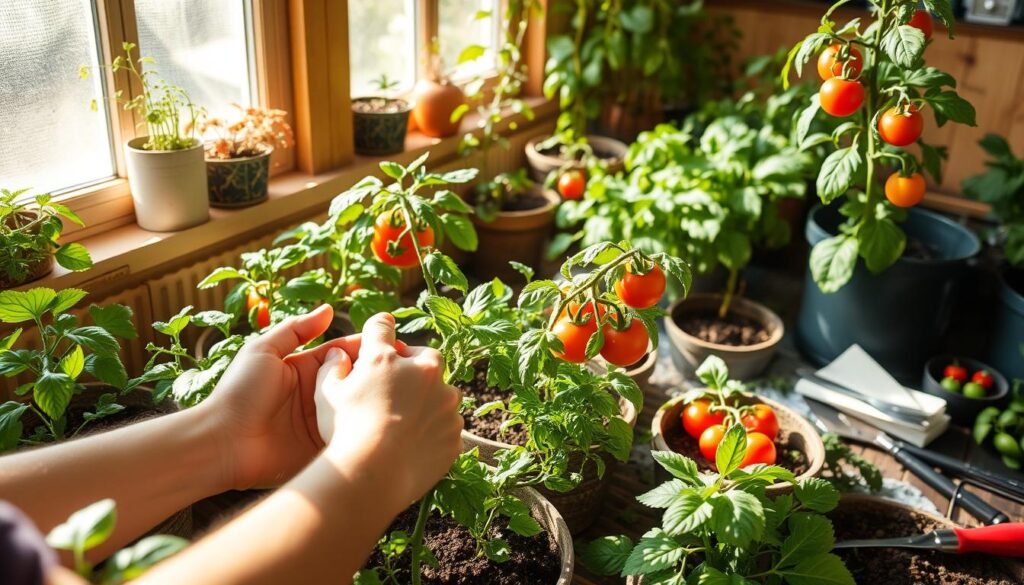
Conclusion
Indoor vegetable gardening offers seniors a fulfilling hobby that can significantly improve their physical and mental well-being. By carefully selecting the right plants, creating the ideal growing environment, and diligently caring for their indoor garden, older adults can enjoy the rewards of homegrown produce, even with limited mobility or small living spaces. With these easy-to-follow tips, seniors can successfully establish and maintain a thriving indoor vegetable garden, reaping the numerous benefits it provides.
Through indoor gardening, seniors can experience the restorative and physical advantages that contribute to their positive self-perceptions of aging. Additionally, engaging in communal gardening activities can foster social connections, reduce isolation and loneliness, and enhance overall community well-being. By incorporating moderate to heavy gardening tasks into their weekly routine, older adults can also lower their risk of morbidity and mortality, particularly for those with cardiovascular disease.
As the second most commonly reported leisure-time physical activity among older adults, indoor gardening presents a valuable opportunity to maintain and promote psychosocial and physical functioning, ultimately enhancing the quality of life for seniors. While this area remains one of the least systematically studied aspects of older adults’ well-being, the available research highlights the profound impact that indoor vegetable gardening can have on the lives of seniors.
FAQ
What are the benefits of indoor gardening for seniors?
Indoor gardening can help seniors with depression, stress, and loneliness, and may even reduce the risk of dementia. It increases physical activity, lowers depression, relieves stress and anxiety, and gives a sense of accomplishment.
What are some good indoor garden types for seniors?
Some of the best indoor garden types for seniors include vertical gardens, terrariums, windowsill herb gardens, and succulent gardens. These options require little effort and are well-suited for older adults with limited mobility.
What factors should seniors consider when choosing a location for their indoor garden?
When choosing a home for your indoor garden, the main things to consider are light, avoiding cold, drafty spaces, and ensuring good air circulation. Seniors should look for areas with adequate sunlight or consider using a grow light.
What are some tips for successful container gardening for seniors?
Seniors should look for lightweight, well-draining soil that won’t compact easily, and containers with drainage holes to prevent root rot. Decorative containers can work, but functionality is key for successful indoor gardening.
What are some good vegetable and herb varieties for indoor cultivation?
Good options include dwarf tomatoes, compact sweet peppers, leafy greens like lettuce and kale, radishes, beets, carrots, and a variety of herbs like basil, cilantro, parsley, mint, and rosemary. These are well-suited for indoor growing in small spaces.
How can seniors properly care for their indoor vegetable garden?
Proper watering and feeding are crucial. As a general rule, water when the soil is dry about an inch down, and be careful not to overwater. Feed your plants with a nutrient-rich fertilizer every 7 days, starting about a month after planting.
How can seniors deal with pests in their indoor vegetable garden?
Pests like whiteflies, aphids, mealybugs, and fungus gnats can sometimes invade indoor vegetable gardens. A strong spray of water is often an effective treatment, especially when targeting the undersides of leaves. Keeping a close eye on your plants and addressing any pest issues quickly is key.

